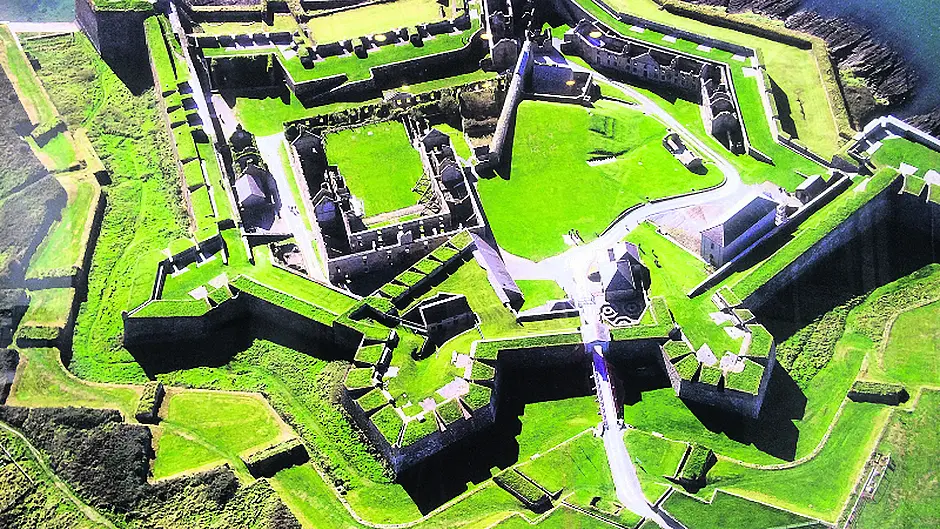Set majestically at the entrance to Kinsale harbour, Charles Fort has had many lives, but its windswept setting gives Jackie Keogh a ‘Poldark’ moment
Set majestically at the entrance to Kinsale harbour, Charles Fort has had
many lives, but its windswept setting gives Jackie Keogh a ‘Poldark’ moment
MOSTLY, I go to Kinsale for cake. A slice of lemon drizzle cake at the Lemon Leaf Café is invariably a reward for something or other, but there are times, too, when it’s merely a consolation.
But I’m guessing that it’s not really about the cake at all because places, like Kinsale, are destinations in, and of, themselves. A trip there probably has more to do with getting out of Dodge, and enjoying ‘a day in the life’ of a town that is not your own.
Without doubt Kinsale is one of the most beautiful seaside towns in the country. Its narrow, meandering streets and colourful buildings are a joy to behold at any time of the year.
But, just recently, I’ve discovered that for less than the price of a mid-day indulgence, I can enrich my understanding and experience of the town by visiting Charles Fort, which is one of the finest examples of a 17th century fortification in Ireland.
An ex-navy guy, walking the timber bridge over the moat, says he never gets tired of the place. On this particular day, he is driving a coach load of tourists, but is happy to be a tourist too – despite the fact that it’s just a hair’s breadth removed from his own tough training days at Haulbowline.
Even if you are not into history, or militaria, how many times in your life do you actually get to say: ‘I think I’ll walk the ramparts.’ And how many times can you visit a star-shaped fort that was built following the Battle of Kinsale in 1601?
I call it “Poldark” moments. You don’t need to have read Winston Graham’s series of historical novels about Cornwall in the 18th century to appreciate the sting of the salt air in your nostrils, or the wind whipping your hair.
You don’t even need a developed imagination to get a real sense of what it was like to have lived within the massive stonewalls of this Bastion fort, which was completed in 1682.
Considering that Charles Fort continued to be garrisoned throughout the 19th century, and was used for training purposes until 1921, when the British withdrew, following the establishment of the Irish Free State, it is ‘living history.’
Then there was that whole other chapter when the British burned most of the buildings as they were leaving, causing the Fort to remain in a desperate state of decay for decades.
For a brief period, the Casemate Soldiers Quarters even became a hippie commune before the State stepped in and made it a National Monument in 1973.
Since then, a programme of extensive repair and conservation has been undertaken and the Office of Public Works (OPW) has done incredible work in terms of its authentic preservation of Charles Fort and making it a ‘must see’ tourist destination.
At first glance within the compound, the barrack stores looks like it must have been the proverbial ‘big house’ but my knowledgeable tour guide, Alice Whitelaw, quickly disabused me of the notion because it would have been too much of a target from passing ships.
Today, the barracks is the OPW’s main exhibition area where you can learn all about the history of the fort. There are artefacts and audio-visual displays – actors in uniforms giving you a flavour of what daily life was like. And in the small fire engine house right next to it, there is an exhibition about World War I and the Kinsale men who were involved in it.
If you follow the lower gravel path, you will come to the gunpowder magazine where there is a fascinating photographic exhibition. And you can walk then to the Governor’s House, where you might see an apparition of The White Lady.
On the lower gravel path to the barrack buildings, where the soldiers would have lived, you can see some of the old surviving fireplaces and how close these living quarters really were. Of course, the officers’ quarters were a cut above and it is incredible to see the photographs of how well they lived within these walls.
But it is walking along the upper ramparts that you get a real sense of how strategically well placed this fort was. There you can only marvel at the Flagstaff, North, East, Charles and Devil’s bastions.
My guide, Alice, who is doing a masters in museum studies at University College Cork, is currently working on a ‘Living History Project’ – the aim of which is to collect data from the 1950s and 1960s at Charles Fort.
‘The aim is not only to preserve these memories,’ she said, ‘but to help local children to understand how the fort has changed, and connect with their community’s heritage.’
If you would like to share your stories and experiences of Charles Fort, you are welcome to call in, phone 021 4772263, write to Charles Fort, Summercove, Kinsale, or email: [email protected]
How to Get There: Drive past The Spaniard pub to the top of the hill at Ardbrack and then down the other side to The Bullman’s pub. Then it is just a short drive up the hill in front of you and you’ll find plenty of free parking at the entrance to Charles Fort.
What it costs:
The entry fee is €4 per adult; €3 for senior citizens or if you are part of a group; €2 if you are a child; and the family ticket is €10.
How long to spend:
History buffs could really get lost in Charles Fort because it has had so many incarnations, but you could also just give it an hour for your first immersion, so to speak, before deciding to make it a regular place to visit when in Kinsale. For those curious about the coffee and cake quotient – it does have a delightful café. West Cork. And then there are the views of the bay – they are, quite simply, stunning.









